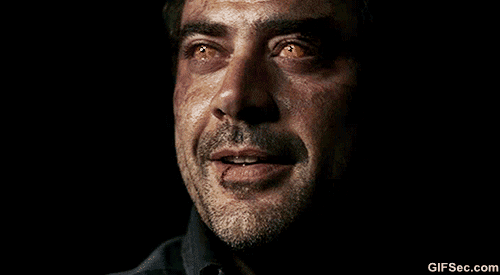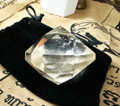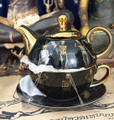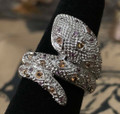 Loading... Please wait...
Loading... Please wait...Aunt Nadiene's Thai 22k White Gold Vermeil, Baroque Pearl, Ruby, Yellow Sapphire, Rhodolite Garnet and Peridot Gem Octopus Ring - A Séance Spirit Reading Room Find - The Voodoo Estate
Product Description

Aunt Nadiene's Thai 22k White Gold Vermeil, Baroque Pearl, Ruby, Yellow Sapphire, Rhodolite Garnet and Peridot Gem Octopus Ring
~:~
It has now been twenty-three and a half years ago since we were called to do an estate that had been closed up for seventeen years!
The Voodoo Estate!
This type of call usually gets us excited as they are a treasure trove. Located here in Florida, there was no electricity or running water so we rigged our own lighting and in we went. If you have ever seen the Adams Family you will have some idea as to what we were greeted with! Then the attorney handling the liquidation gave us some background. The estate had belonged to an alleged powerful Voodoo Priestess/JooJoo Exorcist, grand daughter of a Marie Laveau, and favored daughter of a Marie Glapion.
These names meant nothing to us, but the late night talk of Voodoo and exorcism in the old mansion was enough to make us decide to spend the night in a hotel and return in the morning to assess the estate. The rest is history.
Our research has shown that this woman was what she claimed and was indeed descended from a long line of well known Vodoun family originating in New Orleans in the early 1800's.
We were pretty unnerved by this until we discovered they were also devout Catholics! Although I have to admit this was unlike any Catholic home we have ever been in and some of the items found inside were a little more than disturbing.
There was no feeling of dread or unwelcome in the mansion, however there was quite a bit of contraband and other items we can or will not sell here.
This is one of a few pieces from this estate we will be listing this week, so check our other listings.
We will, upon the new guardian's request, issue a named Letter of Authenticity with each lot from this estate, complying with the terms set forth to us by the estate's attorney.
Some Back Story
This is the seventh of the eighteen Thai vermeil and gemstone rings that were found and recovered from a commercial, ring rack display in a cabinet that served her main séance and reading room. These rooms were a commercial endeavor that had a wealthy following and it is where many of the major séances of this estate were conducted. Many, if not all of her associates worked this room, conducting séances, card readings and numerous forms of divination for their clientele. Apparently this was a lucrative endeavor, as it remained active for over six decades.
Her journals list a host of well known psychics, mediums and other celebrities that would make guest appearances and that these events were booked to capacity well in advance.
They also tell us the ring is one of many her Aunt Nadiene had made for her by a Thai jeweler of Chanthaburi in 1956/57. This jeweler had copied a handful of gold and gemstone rings in vermeil, many of which were gifted to and inherited by her niece.
While there, she purchased a sizable quantity of jewelry to be sent home for resale to their clients. Often times claiming to cast spells or attach spirits to a selected piece of jewelry at a client's request, as in the case of this ring.
Aunt Nadiene
Although not a blood Aunt, she had been "taken into the fold as a child found" by her "mother" as she was said to refer to Marie Glapion. Further chronological investigation revealed her to be the daughter of a prostitute that was in her mother's (Marie Glapion) employ. Other notes found might lead one to believe her mother was an Algul. Described as a vampiric jinn like creature they claimed to have encountered in remote desert regions.
Our own research has not revealed very much other than Algul literally translates to "horse-leech" or "blood-sucking Jinn." An example was found in the 'Thousand and One Nights' as Amine. Although a drinker of blood, it is a Jinn, or demon that was never human. Unkillable by most means, it can be destroyed by fire and sometimes magic. Most inhabited unchartable regions of desert, but oil production has driven them from their homes and she claims, "they live among us, posing no threat to adults save sexual fulfillment, but they must be watched around children and livestock."
~!~
It is not clear if Aunt Nadiene was abandoned by her mother or if the mother died, orphaning the girl, but she was apparently treated and referred to as a family member, indoctrinated along with her "niece", and for many years she was her traveling companion and guardian.
Her journals note of Aunt Nadiene's passing in 1966.
She also notes of wearing Aunt Nadiene's jewelry, "Connected to her so closely in life, it awakens psychic qualities with a feeling of devotional joy to wear them."
Other journal entries allege incidents of Aunt Nadiene, "owl shape shifting", claiming the Great Horned Owl as being her spirit guide or token spirit animal, and because of this, her taking due care in the handling of owls in her bird and reptile ceremonies, not submitting them to the torturous ceremonial deaths many other species endured during these ceremonies.
She also notes of a number of dreams in which a Great Horned Owl wearing her aunt's jewelry would appear to her. They also go into detail of her gazing into her stones (sphere's), to draw upon Aunt Nadiene's power to help her in this life.
~!~
These have all been bezel set and are further described below.
~!~
Baroque Pearl
From Wikipedia, the free encyclopedia, for the most part...
Baroque pearls are pearls with an irregular non-spherical shape. Shapes can range from minor aberrations to distinctly ovoid, curved, pinch, or lumpy shapes. Most cultured freshwater pearls are baroque because freshwater pearls are mantle-tissue nucleated instead of bead nucleated. Cultured saltwater pearls can also be baroque, but tend to be more teardrop-shaped due to the use of a spherical nucleation bead.
The most valuable of baroque pearls are the South Sea and Tahitian pearls. These pearls are produced by Pinctada margaritifera (black-lipped oysters) and Pinctada maxima (gold-lipped and white-lipped oysters). Although these are a variety of cultured saltwater pearls, the amount of time that the pearls are cultured dramatically increases the depth of the nacre, and the likelihood of producing a baroque pearl. Most Tahitian pearl farm harvests, for example, produce more than 40 percent baroque and semi-baroque pearls. Western Australia is currently the world's largest cultivator of Pinctada maxima gold-lipped oysters. Tahiti is the number one cultivator of Pinctada maxima black-lipped oysters.~!~
The baroque pearl used in this ring has been artistically set. Most likely drilled and pinned.
~!~
Some of her journal entries concerning rubies read; "Their color brings light and change into your world.”
~!~
~!~
The Rhodolite Garnet Gem
The single faceted round rhodolite garnet gem is of good to fine cut and violet/red color with minor loupe visible inclusions and an abundance of flash.
She tells us that Rhodolite garnet gems are "vivid dream stones of past life remembrance. These are energies of love and life that enhance these within us. It cleanses and renews, comforts and protects, doing well for those in need of self respect."
"Assuredly dream work stones that have been aggressive in past life recall with strong tendencies to formulate love and bonding."
"The stone draws happiness and are an aid to sexuality sharpening perceptions to allow creative energies to whet the sexual appetite. If worn during cycle it will help to control a bad months flow."
~!~
She does write of her own feelings and observations concerning peridot. One of her journal entries reads; "Peridot
contains powerful, fast acting amplified energies that boost self esteem, but I must caution its use to when one is in complete control as its energies can work too quickly to control. With an unusual stimulation of the physical senses the serenity of the spiritual senses are easily achieved when worn or carried and, it will be of aid to those seeking spiritual growth. A true visionary crystal with energies that stimulate cleansing when focused through the heart. It's energies attune to high spiritual forces. They have proven useful in treating clients suffering from heart, and intestinal disorders."
Octopus
Excerpts from Wikipedia, the free encyclopedia article;
The octopus (plural octopuses) is a soft-bodied, eight-limbed mollusk of the order Octopoda. Around 300 species are recognized, and the order is grouped within the class Cephalopoda with squids, cuttlefish, and nautiloids. Like other cephalopods, the octopus is bilaterally symmetric with two eyes and a beak, with its mouth at the center point of the eight limbs. The soft body can rapidly alter its shape, enabling octopuses to squeeze through small gaps. They trail their eight appendages behind them as they swim. The siphon is used both for respiration and for locomotion, by expelling a jet of water. Octopuses have a complex nervous system and excellent sight, and are among the most intelligent and behaviorally diverse of all invertebrates.
Octopuses inhabit various regions of the ocean, including coral reefs, pelagic waters, and the seabed; some live in the intertidal zone and others at abyssal depths. Most species grow quickly, mature early, and are short-lived. In most species, the male uses a specially adapted arm to deliver a bundle of sperm directly into the female's mantle cavity, after which he becomes senescent and dies, while the female deposits fertilized eggs in a den and cares for them until they hatch, after which she also dies. Strategies to defend themselves against predators include the expulsion of ink, the use of camouflage and threat displays, the ability to jet quickly through the water and hide, and even deceit. All octopuses are venomous, but only the blue-ringed octopuses are known to be deadly to humans.
Octopuses appear in mythology as sea monsters like the Kraken of Norway and the Akkorokamui of the Ainu, and probably the Gorgon of ancient Greece. A battle with an octopus appears in Victor Hugo's book Toilers of the Sea, inspiring other works such as Ian Fleming's Octopussy. Octopuses appear in Japanese erotic art, shunga. They are eaten and considered a delicacy by humans in many parts of the world, especially the Mediterranean and the Asian seas.
The giant Pacific octopus (Enteroctopus dofleini) is often cited as the largest known octopus species. Adults usually weigh around 15 kg (33 lb), with an arm span of up to 4.3 m (14 ft). The largest specimen of this species to be scientifically documented was an animal with a live mass of 71 kg (156.5 lb). Much larger sizes have been claimed for the giant Pacific octopus: one specimen was recorded as 272 kg (600 lb) with an arm span of 9 m (30 ft). A carcass of the seven-arm octopus, Haliphron atlanticus, weighed 61 kg (134 lb) and was estimated to have had a live mass of 75 kg (165 lb). The smallest species is Octopus wolfi, which is around 2.5 cm (1 in) and weighs less than 1 g (0.035 oz).
External Characteristics
The octopus is bilaterally symmetrical along its dorso-ventral axis; the head and foot are at one end of an elongated body and function as the anterior (front) of the animal. The head includes the mouth and brain. The foot has evolved into a set of flexible, prehensile appendages, known as "arms" that surround the mouth and are attached to each other near their base by a webbed structure. The arms can be described based on side and sequence position (such as L1, R1, L2, R2) and divided into four pairs. The two rear appendages are generally used to walk on the sea floor, while the other six are used to forage for food; hence some biologists refer to the animals as having six "arms" and two "legs". The bulbous and hollow mantle is fused to the back of the head and is known as the visceral hump; it contains most of the vital organs. The mantle cavity has muscular walls and contains the gills; it is connected to the exterior by a funnel or siphon. The mouth of an octopus, located underneath the arms, has a sharp hard beak.
The skin consists of a thin outer epidermis with mucous cells and sensory cells, and a connective tissue dermis consisting largely of collagen fibres and various cells allowing colour change. Most of the body is made of soft tissue allowing it to lengthen, contract, and contort itself. The octopus can squeeze through tiny gaps; even the larger species can pass through an opening close to 2.5 cm (1 in) in diameter. Lacking skeletal support, the arms work as muscular hydrostats and contain longitudinal, transverse and circular muscles around a central axial nerve. They can extend and contract, twist to left or right, bend at any place in any direction or be held rigid.
The interior surfaces of the arms are covered with circular, adhesive suckers. The suckers allow the octopus to anchor itself or to manipulate objects. Each sucker is usually circular and bowl-like and has two distinct parts: an outer shallow cavity called an infundibulum and a central hollow cavity called an acetabulum, both of which are thick muscles covered in a protective chitinous cuticle. When a sucker attach es to a surface, the orifice between the two structures is sealed. The infundibulum provides adhesion while the acetabulum remains free, and muscle contractions allow for attachment and detachment.
The eyes of the octopus are large and are at the top of the head. They are similar in structure to those of a fish and are enclosed in a cartilaginous capsule fused to the cranium. The cornea is formed from a translucent epidermal layer and the slit-shaped pupil forms a hole in the iris and lies just behind. The lens is suspended behind the pupil and photoreceptive retinal cells cover the back of the eye. The pupil can be adjusted in size and a retinal pigment screens incident light in bright conditions.
Nervous System and Senses
The octopus (along with cuttlefish) has the highest brain-to-body mass ratios of all invertebrates; it is also greater than that of many vertebrates. It has a highly complex nervous system, only part of which is localized in its brain, which is contained in a cartilaginous capsule. Two-thirds of an octopus's neurons are found in the nerve cords of its arms, which show a variety of complex reflex actions that persist even when they have no input from the brain. Unlike vertebrates, the complex motor skills of octopuses are not organized in their brain via an internal somatotopic map of its body, instead using a nonsomatotopic system unique to large-brained invertebrates.
Nearly all octopuses are predatory; bottom-dwelling octopuses eat mainly crustaceans, polychaete worms, and other mollusks such as whelks and clams; open-ocean octopuses eat mainly prawns, fish and other cephalopods. Major items in the diet of the giant Pacific octopus include bivalve mollusks such as the cockle Clinocardium nuttallii, clams and scallops and crustaceans such as crabs and spider crabs. Prey that it is likely to reject include moon snails because they are too large and limpets, rock scallops, chitons and abalone, because they are too securely fixed to the rock.
Intelligence
Octopuses are highly intelligent; the extent of their intelligence and learning capability are not well defined. Maze and problem-solving experiments have shown evidence of a memory system that can store both short- and long-term memory. It is not known precisely what contribution learning makes to adult octopus behavior. Young octopuses learn nothing from their parents, as adults provide no parental care beyond tending to their eggs until the young octopuses hatch.
In laboratory experiments, octopuses can be readily trained to distinguish between different shapes and patterns. They have been reported to practice observational learning, although the validity of these findings is contested. Octopuses have also been observed in what has been described as play: repeatedly releasing bottles or toys into a circular current in their aquariums and then catching them. Octopuses often break out of their aquariums and sometimes into others in search of food. They have even boarded fishing boats and opened holds to eat crabs. The veined octopus collects discarded coconut shells, then uses them to build a shelter, an example of tool use.
Relationship to Humans
Ancient seafaring people were aware of the octopus, as evidenced by certain artworks and designs. For example, a stone carving found in the archaeological recovery from Bronze Age Minoan Crete at Knossos (1900–1100 BC) has a depiction of a fisherman carrying an octopus. The terrifyingly powerful Gorgon of Greek mythology has been thought to have been inspired by the octopus or squid, the octopus itself representing the severed head of Medusa, the beak as the protruding tongue and fangs, and its tentacles as the snakes. The Kraken are legendary sea monsters of giant proportions said to dwell off the coasts of Norway and Greenland, usually portrayed in art as a giant octopus attacking ships. Linnaeus included it in the first edition of his 1735 Systema Naturae. One translation of the Hawaiian creation myth the Kumulipo suggests that the octopus is the lone survivor of a previous age. The Akkorokamui is a gigantic octopus-like monster from Ainu folklore.
Japanese erotic art, shunga, includes ukiyo-e woodblock prints such as Katsushika Hokusai's 1814 print Tako to ama (The Dream of the Fisherman's Wife), in which an ama diver is sexually intertwined with a large and a small octopus. The print is a forerunner of tentacle erotica. The biologist P. Z. Myers noted in his science blog, Pharyngula, that octopuses appear in "extraordinary" graphic illustrations involving women, tentacles, and bare breasts.
Danger
Octopuses generally avoid humans, but incidents have been verified. For example, a 2.4-metre (8 ft) Pacific octopus, said to be nearly perfectly camouflaged, "lunged" at a diver and "wrangled" over his camera before it let go. Another diver recorded the encounter on video.
All species are venomous, but only blue-ringed octopuses have venom that is lethal to humans. Bites are reported each year across the animals' range from Australia to the eastern Indo-Pacific Ocean. They bite only when provoked or accidentally stepped upon; bites are small and usually painless. The venom appears to be able to penetrate the skin without a puncture, given prolonged contact. It contains tetrodotoxin, which causes paralysis by blocking the transmission of nerve impulses to the muscles. This causes death by respiratory failure leading to cerebral anoxia. No antidote is known, but if breathing can be kept going artificially, patients recover within 24 hours. Bites have been recorded from captive octopuses of other species; they leave swellings which disappear in a day or two.
Fisheries and Cuisine
Octopus fisheries exist around the world with total catches varying between 245,320 and 322,999 metric tons from 1986 to 1995. The world catch peaked in 2007 at 380,000 tons, and fell by a tenth by 2012. Methods to capture octopuses include pots, traps, trawls, snares, drift fishing, spearing, hooking and hand collection. Octopus is eaten in many cultures and is a common food on the Mediterranean and Asian coasts. The arms and sometimes other body parts are prepared in various ways, often varying by species or geography. Live octopuses are eaten in several countries around the world, including the US. Animal welfare groups have objected to this practice on the basis that octopuses can experience pain. Octopuses have a food conversion efficiency greater than that of chickens, making octopus aquaculture a possibility.
Octopuses offer many possibilities in biological research, including their ability to regenerate limbs, change the colour of their skin, behave intelligently with a distributed nervous system, and make use of 168 kinds of protocadherins (humans have 58), the proteins that guide the connections neurons make with each other. The California two-spot octopus has had its genome sequenced, allowing exploration of its molecular adaptations. Having independently evolved mammal-like intelligence, octopuses have been compared to hypothetical intelligent extraterrestrials. Their problem-solving skills, along with their mobility and lack of rigid structure enable them to escape from supposedly secure tanks in laboratories and public aquariums.
Due to their intelligence, octopuses are listed in some countries as experimental animals on which surgery may not be performed without anesthesia, a protection usually extended only to vertebrates. In the UK from 1993 to 2012, the common octopus (Octopus vulgaris) was the only invertebrate protected under the Animals (Scientific Procedures) Act 1986. In 2012, this legislation was extended to include all cephalopods in accordance with a general EU directive.
Some robotics research is exploring biomimicry of octopus features. Octopus arms can move and sense largely autonomously without intervention from the animal's central nervous system. In 2015 a team in Italy built soft-bodied robots able to crawl and swim, requiring only minimal computation. In 2017 a German company made an arm with a soft pneumatically controlled silicone gripper fitted with two rows of suckers. It is able to grasp objects such as a metal tube, a magazine, or a ball, and to fill a glass by pouring water from a bottle.
~!~
But Back to the Ring
The ring is marked "925" with no maker's or assay marks, and tests as .925 Sterling Silver Standard.
It is a ring size 8.5, and the ring face measures approximately 1 7/16" x 15/16" x 7/16", and weighs 9 grams.
We have been contacted and visited by a number of people who were interested in the items from this estate since our first batch was listed. Among the buyers have been known psychics and practitioners. More than one, after adorning themselves or handling their purchase, stated "this is a woman of power!" Many of our customers, after receiving items from this estate have reported dream contacts and other unexplained phenomenon.
Unusual, authentic Voodoo Priestess Estate piece and at a bargain price!
This is truly a rare opportunity to own anything with attributes to this estate. The majority of this estate is now gone. Most of what we had left, and it was considerable, has been split up and sold to a couple of private, foreign collector practitioners and will never be available to the public again. We made the decision to do this as we have had some pretty strange visits from even stranger individuals and there have been enough unexplained phenomenon going on in the warehouse where her things were kept that many of our employees refused to go in there.
The pieces offered and sold here are some of the few remaining pieces that will ever be offered to the public.
Nice addition to any collection, altar, wardrobe or decor, displays really well.
Really doesn't get any better than this.
There are 10 photographs below to tell the rest of this tale.
Buyer to pay $0.00 for Insured Ground Shipping to the lower 48 with Tracking and our outstanding handling with lagniappe.
Rest assured your order will be carefully packed to withstand the onslaught of the most deranged of package carriers.

International Buyer's, Please email us for a Shipping Quote.
Payment is due at listing end. Check our other listings, and sign up for our newsletter as new items are usually listed daily.
©Text and Photos Copyright 2001-2025 bushidobuce, all rights reserved.
~!~
























